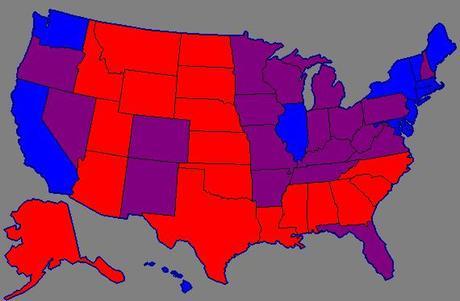
Alignments in 2008. What will they be like in 2020?
A recent Pew Research Center poll produced some interesting findings. How will the political landscape be different in a few decades? Obviously, it's impossible to know for sure, but this data provides the tools to make some pretty sound guesses. In the poll, those whose responses were consistent with Democrats comprised 37% of all takers, while Republicans made up 20%. Another 20% were right-leaning independents, with 13% left-leaning independents and 10% politically apathetic. Women comprised 57%, 61%, and 56% of the three Democratic subcategories (in this case ranked from most liberal to most conservative). In contrast, women comprised just 44% and 50% of the "Staunch Conservative" and "Main Street Republican" groups, respectively. The ratio of women to men in the US remains relatively constant, so these disparities are unlikely to produce earthshaking political shifts in the coming years. On the other hand, other rapidly expanding demographic groups have the potential to produce a strikingly different political arena in the future.For instance: Hispanics, the fastest-growing ethnic categorization in the United States, represented 38% of all apathetic "Bystanders" in the survey (those not registered to vote). However, they made up 26% of all "New Coalition Democrats," and just 4% of all "Main Street Republicans." While Hispanic-Americans are clearly unlikely to vote Republican, they also compose a large fraction of those with no political sympathies. As immigration from Latin America continues in the years to come, it seems that growing Democratic margins of victory might coincide with shrinking voter turnout percentages. It's clear that both parties could benefit from policies and leaders to galvanize what looks to be a group of increasingly disenfranchised Americans.
Over 51% of nonvoting "Bystanders" are in the 18-29 age group. This also presents an opportunity for both parties, more notably for the visibly-aging GOP (28% of "Staunch Conservatives" were over 65, a higher percentage than in any other political faction). While the Democrats have done better at ideologically attracting young voters, neither party is doing particularly well at engaging them and pulling significant numbers into its base. "Staunch Conservatives" are only 8% youth, and "Hard-Pressed Democrats" have just 12% of their support from young people. Finally, liberals can take heart in the knowledge that the percentage of Americans with college degrees is steadily rising. Those with a college degree made up 49% of the "Solid Liberal" category, a greater ratio than within any other group (34% of "Staunch Conservatives" and only 10% of "Bystanders").
While the Pew Research Poll is interesting, it's clearly one of many factors to consider. To conclude this post, here are a few poll numbers relating to policy, from the same survey:
- 38% believe the USA"stands above all other countries."
- 47% (a plurality) believe Wall Street does more harm than good economically.
- 52% place Middle East stability as more important than Middle East democracy.
- 48% (a plurality) see free trade as good for the economy.
- 72% support easier paths to citizenship for immigrants.
- 54% support the legality of abortion.
- 63% place alternative energy as more of a priority than fossil fuels.







